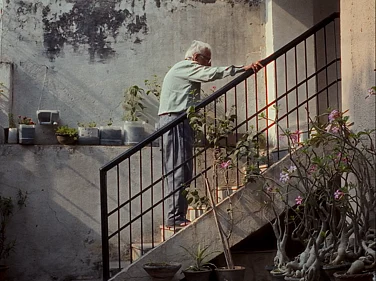Thirteen minutes before the end of the one-hour-and-55-minute-long film, the husband, who had gone mad since his wife went missing some months ago, incidentally reaches a spot along a ghat on the Hooghly river from which a skeleton had just been recovered. He runs to the skeleton, grabs and hugs it crazily, and draws it onto his lap. He identifies it as his wife Tarala’s by the bangle on its wrist that had his name embossed on it. He refuses to let go of his ‘wife’.
The family friend, a doctor who had driven him to the spot, agrees to take the skeleton back with them and the locals don’t object to it. The skeleton would be of best use to a doctor, they agree.
ALSO READ: Horror As The Theme Of Our Lives
Back in Calcutta, inside the doctor’s chamber, the skeleton is kept in a standing posture on a base. One day, as the doctor falls asleep on his chair out of fatigue, one hand of the skeleton tenderly runs the fingers through the doctor’s hair. He wakes up but is not scared. He asks the skeleton to return to its “original shape”. As it takes the shape of the missing woman, the doctor asks for the name of her murderer, so that he can be punished. But, the skeleton replies, there is no need for it, as she would complete the task herself.
Some moments later, the culprit, also an acquaintance of the doctor, enters the chamber when it is empty. He is shocked by the presence of the skeleton and again upon spotting the iron bangle—a Bengali Hindu wedding marker—on its wrist. The skeleton then grabs him by the throat and yanks him up in the air. He is dead in seconds. The doctor, who rushes in along with others upon hearing the screams, heaves a sigh of relief.
The police, who were already on the lookout for the man in connection with a case of theft, reach the spot to find him sprawled on the floor. With a wry smile, the doctor informs police, “A power greater than you has already punished him.”
The story is from Naresh Mitra’s 1950 feature Kankal (Skeleton)—considered the first Bengali horror talkie. It was just a year after the release of Mahal in Hindi, often considered the first successful Indian horror film. Kankal is also considered the only one of this genre in Bengali cinema in the 1950s. From the same period, poet-filmmaker Premendra Mitra’s Kalo-Chhaya (1948) and Hanabari (1952) are usually described as suspense thrillers. In place of a ghost, Hanabari had an ape-like beast as the main source of horror and a whodunnit became the driver of the narrative.
Since Kankal, ghosts have appeared in Bengali cinema with a wide range of purposes—from the King of Ghosts showering three incredibly powerful boons on the protagonists of Satyajit Ray’s Goopy Gyne Bagha Byne (1969), to the ghost of the zamindar which fails to grab an orchard from a farmer in Tapan Sinha’s 1980 classic Banchharamer Bagan, and the ghost of pishima (paternal aunt) protecting her jewellery box in Aparna Sen’s Goynar Baksho (2013). More than horror, they served the purpose of comedy. But almost always, they were meant to convey some social message.
In contrast, Kankal had no pretence of allegory or metaphor in its use of the supernatural. One of its protagonists—the doctor—had placed strong arguments in favour of the existence of spirits soon after carrying the skeleton back to Calcutta. At the time of its release, the film had earned critical praise for its technical dexterity, despite glaring holes in the plot.
But horror movies as a genre did not pick up pace in Tollygunj, even though suspense thrillers, often with a tinge of the occult, kept getting made to popular acclaim. Most notable Bengali ghost films display certain common themes—from unsatisfied desire to unfulfilled life mission, ensuring justice to supporting the underprivileged—and are rarely spooky.

Two of the most notable ghost movies in Bengali are adaptations of Rabindranath Tagore’s short stories. In Tapan Sinha’s 1960 movie, Kshudhito Pashan, a tax collector who reaches a village and decides to put up in a palatial “haunted house” till his work is over, finds himself living amid ghosts of women victims of the original owner. A particular ghost starts engaging with him, lures him to nooks and crannies of the palace—but instead of developing into another Gothic romance, the narrative brings to the fore two centuries of history.
ALSO READ: The Ghost As A Metaphor In Bengali Cinema
The 1961 film Monihara (The Lost Jewels)—a segment in Satyajit Ray’s Teen Kanya—is an adaptation of Tagore’s eponymous short story, in which the ghost of a wealthy businessman’s dead wife returns to reclaim her jewellery. It is the only horror film in Ray’s oeuvre.
“Loneliness is the theme of Monihara,” British author Andrew Robinson wrote in his book Satyajit Ray: The Inner Eye. “Ray’s story is considerably different from Tagore’s… he has intensified both the mystery and the horror in the original.” He added that Ray’s drama was “mainly psychological”, “flesh-tingling rather than nail-biting”.
With Goopy Gyne Bagha Byne, Ray introduced ghosts in an entirely different way than earlier seen in Indian cinema. The King of Ghosts is perhaps the first benevolent ghost in cinema, and the scene of the dance of the ghosts has gone on to become iconic in Indian cinema.
ALSO READ: The ‘Spirit’Of Filmmaking
Surrounded by dozens of ghosts in the dark of a forest, Goopy the singer and Bagha the drummer are scared, till the King of Ghosts offers them three boons of their choice for pleasing him with their music. These three boons later help them end the tyrannical rule of a despotic king.
Two years later, Tarun Majumdar’s 1971 classic Kuheli opened in theatres. It has been alternatively described as a masterpiece of the genres ‘horror-thriller’ or ‘suspense-thriller’—which has few peers in Bengali cinema. Here, a woman who lands in a godforsaken place called Nijhumgarh as a governess at a bungalow, starts noticing events that defy logic and explanation. These eventually get linked to murders that took place in the house some years ago. Lata Mangeshkar’s songs added to the eerie atmosphere, just like her voice had done in the 1949 Hindi film, Mahal. Kuheli was a major box office success.
ALSO READ: Resident Evil: The Zombie Apocalypse In Goa
In Tapan Sinha’s Banchharamer Bagan, though, the ghost serves more the purpose of comedy than horror. Adapted from playwright, actor-theatre-director Manoj Mitra’s play Sajano Bagan, the ghost of the greedy zamindar in this film is in no way spooky. Rather, it makes the audience laugh. The ghost keeps waiting for orchard owner Banchharam to die, so that his son, the current landlord, can take possession of the land. But though a tenacious Banchharam ages and is crippled by ailments, he just does not die.
For nearly three decades since then, Bengali cinema did not produce films on ghosts that could make a mark. The 1989 film Nishi Trishna, dubbed as the first Bengali vampire movie, had no claim to critical acclaim. Though made as a horror film, the present-day viewer would probably find it difficult not to laugh at the ham acting and dull plot.
One of the major constraints of making ghost or horror films is the lack of technology for quality special effects, or their high cost. Of course, the likes of Ray, Sinha or Majumdar could bypass this limitation with careful choice of narratives and deft use of the craft, but then they were acknowledged masters.
The dry spell of good ghost films ended in 2012 with Anik Dutta’s refreshing Bhooter Bhabishyat and Aparna Sen’s Goynar Baksho the next year. In both, the ghosts aren’t scary, but help advance the narrative with wit and metaphor. If Dutta’s story was original, Sen’s was a screen adaptation of Shirshendu Mukhopadhyay’s short novel.
ALSO READ: An Allegory Written In Blood
In an interview after the release of Goynar Baksho, Sen had said that the ghost of pishima from Mukhopadhyay’s story used to chase her. “I liked pishima so much that I did not want to let go of her at the point where Shirshenduda brings her character to an end in the story… so even as a ghost, she keeps evolving. I found it very interesting that someone could be so much in love with life that she can’t forsake it even after dying,” she had said.
(This appeared in the print edition as "Of Boons and Curses")
ALSO READ


























